1283
B0 Shim Array Integrated into a Solenoid TRX Coil for Localized B0 in Permanent Magnet Scanners
Rafael Limgenco Calleja1, Celine Jeyda Veys1, and Michael Lustig1
1Electrical Engineering and Computer Sciences, University of California, Berkeley, Berkeley, CA, United States
1Electrical Engineering and Computer Sciences, University of California, Berkeley, Berkeley, CA, United States
Synopsis
Low-to-mid field systems have nearly been abandoned for high-field, high-performance systems. However, recent improvements in MR hardware, algorithms and computation are stimulating a resurgence in interest of upgrading lower-end magnets to achieve high-performance at significantly lower cost, improved accessibility, portability and siting. Here, we look at upgrading a wrist/animal 1T permanent-magnet system. We integrate a simple B0 array into a solenoid TRX coil for reducing B0 through localized targeted shimming. We demonstrate potential for improved field homogeneity with simulations, and demonstrate homogeneity improvements using a 6-channel prototype array with negligible effects on the transmit field and received SNR.
Introduction
Low-to-mid field systems have nearly been abandoned for high-field, high performance ones. However, recent improvements in MR hardware (receiver arrays, power systems, shim arrays, field-monitoring), as well as algorithms and cheap computation (parallel imaging, compressive sensing, artifact corrections) are stimulating a resurgence in interest of upgrading these lower-end magnets with modern technology to achieve high-performance at significantly lower cost, better accessibility, improved portability and simpler siting requirements. In recent years we have seen several research programs and new commercial companies displaying dedicated low-field or specialized systems for extremities, head and pediatric covering fields between 6.5mT through 0.35T, 0.5T, 0.55T and 1T. All the above is nicely reviewed in [1].Permanent magnets are a class of low-end, inexpensive magnets with the advantage of requiring no power and no cooling to maintain the field. Dedicated permanent magnet MRI can be small, shielded, safe and easy to site. However, these systems can suffer from field inhomogeneity, drift and hysteresis. Localized non-linear shim arrays [2] are a possible solution as demonstrated by [2, 3]. Since they are placed close to the subject, shimming can be achieved with little current, thus making the system simple and affordable.
Permanent magnets in a Halbach configuration generate a uniform field that is orthogonal to the bore [4]. This enables the use of very efficient solenoid RF transmit and receive coils. Since solenoids produce very uniform field inside, and little outside, we look at constructing a shim loop array that covers the solenoid [5]. Each of the elements are orthogonal and naturally decoupled from the RF coil, and the array takes little space and elements are maximally close to the subject. Figure 1 demonstrates the motivation for our work. A field map in a phantom of an Aspect Imaging (Shoham, Israel) Wrist II 1T system shows significant field inhomogeneities with global linear shims. Simulations of a 16 channel local shim array can provide substantial slice-by-slice local field homogeneity corrections in all directions.
The aim of the study is to demonstrate the efficacy of using a localized shim loop array, wrapped around a solenoid RF coil both in simulations and practice. In addition, we aim to demonstrate minimal interaction between our shim array and the RF system.
Methods
Methods: All studies were performed using an Aspect Wrist II 1T MRI system, using a wrist solenoid transmit receive coil. B0 field mapping was performed using a product B0 mapping 3D RF spoiled gradient echo sequence.Simulations: A Biot-Savart simulation was written to estimate the B0 field for an arbitrary number of loops and sizes [6]. The code was implemented in Matlab. In addition, a constrained Least-squares shimming procedure for determining the shim-currents, given each loop contribution to the field map as well as targeted maps was implemented in Matlab using CVX [7, 8].
Implementation: A 1-sided 6 channel shim loop array (Figure 1a) was constructed using 1.25µm thick, copper tape on a polycarbonate plate. These were arranged in 2x3 configuration covering 100 cm2 coronal area of the coil. Each loop was driven with direct current generated by a lab-power-supply via shielded twisted-pair wires fed into the bore (Figure 1a).
Experiments: Calibration was performed using a CuSO4 doped water-bottle phantom for field mapping. The background B0 map was obtained, followed by 6 scans to map the field generated individually by each loop. The loop current in the calibration was set to 1A. Shim-currents were then applied, based on the optimization to locally shim specific coronal slices. In addition, simulations were also performed to validate the shimming performance for 6-channels, and predict the shimming ability for 16-channels. To measure the effect of the shim array on SNR, we computed the unloaded Q-factor of the RF coil with-and-without the shim array. Spin-echo images of a calibration phantom were acquired for image SNR comparison.To measure the effect of the shim array on B1 we ran a product B1 mapping sequence with and without the shim-array. B1 were computed via the Aspect Imaging software.
Results and Discussion
Figure 2 shows good correspondence between the simulated and measured B0 field maps of individual loops in the array. Figure 3 shows localized shimming results of two coronal slices, demonstrating improved homogeneity over global linear shimming, and good correspondence to simulations. 16-channel array simulations demonstrate significant future shimming capability. These results are re-emphasized by displaying the histograms of the maps in Figure 4. SNR and B1 measurements indicate minimal coupling between the RF coil and the shim array. Measured SNR was reduced by 10%, and the B1 field map did not show any observable difference (Figure 5).Conclusion
We demonstrated that localized shim arrays can be integrated with solenoid RF coils, with minimal interactions for shimming B0 inhomogeneities in permanent magnet systems. Simulations show significant improvements with 16 channels, which we aim to implement next.Acknowledgements
We would like to thank Aspect Imaging for their support with hardware and software tools, and Jason Stockmann for providing shim boards and documentation.References
- José P. Marques Frank F.J. Simonis Andrew G. Webb PhD “Low field MRI: an MR Physics perspective” JMRI 2019;49(6):1528-42
- Galiana G, Stockmann JP, Tam L, Peters D, Tagare H, Constable RT “The Role of Nonlinear Gradients in Parallel Imaging: A k-Space Based Analysis” 2012 Sep; 40A(5):253-267
- Han, Hui et al. “Integrated parallel reception, excitation, and shimming (iPRES).” Magnetic resonance in medicine vol. 70,1 (2013): 241-7. doi:10.1002/mrm.24766
- Huang, Shao Ying et al. “Portable Low-cost MRI System based on Permanent Magnets/Magnet Arrays” Dec, 2018.
- Wang, Guangxin et al. “Development of the 1.2 T~1.5 T Permanent Magnetic Resonance Imaging Device and Its Application for Mouse Imaging.” BioMedresearch international vol. 2015 (2015): 858694. doi:10.1155/2015/858694
- L. Quéval, “BSmag toolbox user manual,” Tech. report, Dept. Elect. Eng., University of Applied Sciences Düsseldorf, Germany, April 2015. Available: http://www.lqueval.com.
- Michael Grant and Stephen Boyd. CVX: Matlab software for disciplined convex programming, version 2.0 beta. http://cvxr.com/cvx, September 2013.
- Michael Grant and Stephen Boyd. Graph implementations for nonsmooth convex programs, Recent Advances in Learning and Control (a tribute to M. Vidyasagar), V. Blondel, S. Boyd, and H. Kimura, editors, pages 95-110, Lecture Notes in Control and Information Sciences, Springer, 2008. http://stanford.edu/~boyd/graph_dcp.html.
Figures
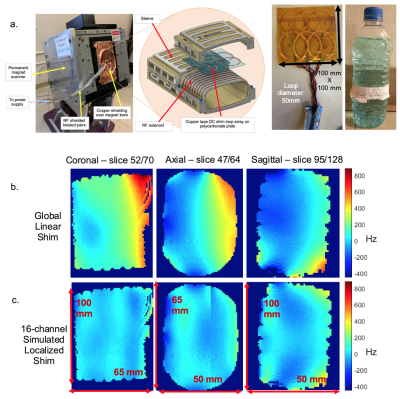
The experiment setup is depicted in (a). The shim loop array is placed between the RF solenoid and the sleeve cover. The bore is copper shielded as a temporary RFI mitigating solution that does not require scanner modification. Right: The constructed shim loop array connected to shielded twisted-pairs and bottle phantom used in this experiment. (b) Global, linear shim field maps showing high level of inhomogeneity, which (c) simulations of a 16-channel array local shimming can nearly eliminate.
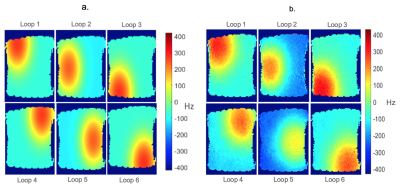
(a) Simulated field map of each of the 6-channel shim loop array elements at applied current of 1A. (b) Measured field maps have good correspondence.
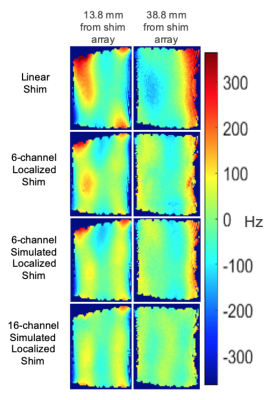
Localized non-linear shim experiments and simulations of two coronal slices. Top: linear global shim. 2nd row: Local shimming with out 6 channel array. 3rd row: Simulated local shimming with 6 channels shows good correspondence to the real experiment. Bottom:Simulation of local shimming with 16 channels demonstrating the ability for future array performance.
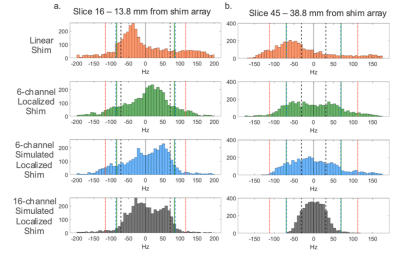
Histograms corresponding to Fig. 3 experiments. The calculated standard deviations of the B0 field maps show significant homogeneity improvements between the linear shim and our 6-channel localized shim.
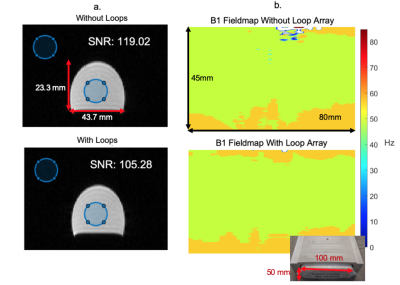
SNR and B1 maps show minimal interaction with the shim-array and the RF system. Q of the coil is 174.3 with loops, and Q = 170.9. (a) 11% reduction of SNR with the presence of the shim array, though the (b) B1 fieldmap is essentially unaffected by the shim array.